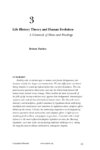1 - 25 of 7
| Creator | Title | Description | Subject | Date | ||
|---|---|---|---|---|---|---|
| 1 |
 |
Hawkes, Kristen | Human life histories: primate trade-offs, grandmothering socioecology, and the fossil record | Human life histories differ from those of other animals in several striking ways. Recently Smith and Tompkins (1995, p. 258) highlighted the combination of "slow" and "fast" features of human lives. Our period of juvenile dependency is unusually long, our age at first reproduction is late, and we h... | Meat; Maturity; Life Span | 2003 |
| 2 |
 |
McElreath, Richard | Can females gain additional paternal investment by mating with multiple males? a game theoretic approach | Although females may require only one mating to become inseminated, many female animals engage in costly mating with multiple males. One potential benefit of polyandrous mating is gaining parental investment from multiple males. We developed two game theoretic models to explore this possibility. Our... | Female multiple mating; Polyandry; Nonprocreative mating; Paternal investment; Mating benefits; Mating strategy | 2001-11 |
| 3 |
 |
Cashdan, Elizabeth A. | Waist-to hip ratio across cultures: trade-offs between androgen-and estrogen-dependent traits | A gynoid pattern of fat distribution, with small waist and large hips (low waist-to-hip ratio, or WHR) holds significant fitness benefits for women: women with a low WHR of about 0.7 are more fecund, are less prone to chronic disease, and (in most cultures) are considered more attractive. Why, then... | Fertility; Optimum; Fecundity | 2008 |
| 4 |
 |
Cashdan, Elizabeth A. | Waist-to-hip ratio across cultures: trade-offs between androgen- and estrogen-dependent traits | A gynoid pattern of fat distribution, with small waist and large hips (low waist-to-hip ratio, or WHR) holds significant fitness benefits for women: women with a low WHR of about 0.7 are more fecund, are less prone to chronic disease, and (in most cultures) are considered more attractive. Why, then... | Fat distribution; Gynoid pattern; Body types; Waist-to-hip ratio; WHR | 2008 |
| 5 |
 |
Hawkes, Kristen | Hadza children's foraging: juvenile dependency, social arrangement and mobility among hunter-gatherers | Presents a study on the foraging activities of Hadza children in Tanzania, Africa. Success of children's foraging; Determinants of children's foraging; Monitoring of the activities of children; Near-camp foraging return rates; Variables underlying the patterns of foraging. | Children; Foraging; Hazda; Hunter-gatherers | 1995 |
| 6 |
 |
Codding, Brian | Behavioral ecology and the future of archaeological science | The future of archaeological science relies as much (if not more) on theoretical as on methodological developments. As with anything in biology, explaining past human behavior will require the application of evolutionary theory. As with anything in archaeology, theory is useless without clear ties t... | 2015-01-01 | |
| 7 |
 |
Hawkes, Kristen | Life history theory and human evolution : a chronicle of ideas and findings | Fertility ends at similar ages in women and female chimpanzees, but humans usually live longer and mature later. We also differ from our closest living relatives in weaning infants before they can feed themselves. The comparisons pose questions about when and why the distinctively human life history... | 2006-01-01 |
1 - 25 of 7
